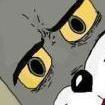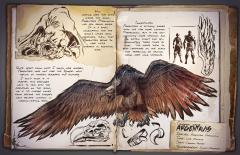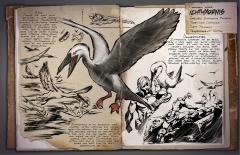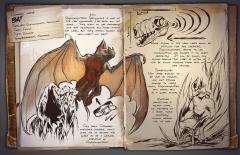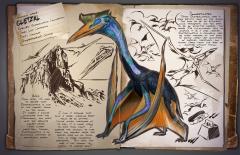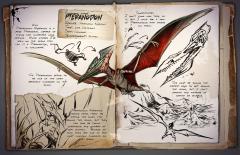Search the Community
Showing results for tags 'flying'.
-
The taming method it will pick you up and eat its taming food which are blood bags, Spoiled meat, Giga heart. giga hearts give most taming it wont have a lot of taming effectivenes so give it a couple dinos to eat. blood is second best spoiled meat is the worst for it. one of its special abilities is that it can go invisible at any time of day. special abilitie is it can wrap its wings around dinos the size of a parasaur or smaller which allows them to heal and do bleed damage dropping the enemies health to 15% and cause a gashing wound. You unlock its saddle at lvl 68. and when it harvests a dead body it gets spoiled meat and regular meat
-
- blood thirst
- carnivore
-
(and 4 more)
Tagged with:
-
EL SEÑOR DE LAS LANZAS (UBIRAJARA) pictures: wikipedia + Dall-E DESCRIPTION The lord of the spears or Ubirajara would be a small flying dinosaur. This dinosaur has four spears in the shape of 2 "V", a "V" on each shoulder that when opening the wings can shoot them anywhere you order. In addition, this dinosaur is able to reproduce formations to facilitate its organization and improve its attack power both on the ground and in the air. DOSSIER Wild The ubirajara jubatus is a dinosaur that can be found in the coldest climates of extinción, they move in packs of approximately 8 individuals, when they feel in danger they shoot their spears from their shoulders. When they are ready to fire, they are placed in formations that improve their attack power thanks to their precision and organization. If you get too close, you can end up with large, deep wounds that can easily be fatal. Domesticated The Ubirajara Jubatus is a very useful creature both as a taming assistant and to fight against dinosaurs or survivors thanks to the various types of spears that they can shoot, also I saw some tribes teaching them to follow formations like they do in the wild, as well as being able to save the most clueless survivors that fall from their flying mount thanks to their ability to glide. ABILITIES "You can't ride this dinosaur" (see below) so in order to use its abilities you have to interact with it. Once you have interacted with the pack leader, it will follow you. FORMATIONS To activate the formations you will have to press the ability key (for example, C). If you are riding a Dino you will need to hold it down, this will bring up an interaction menu from which you can bring your Ubirajara into formation. ON GROUND : They will form a C like formation then you will be able to select the structure/dinosaur/player that you want them to attack with the left click, then they will start shooting projectiles at it. IN AIR : They will form a formation in the form of ">" while flying behind you, a circle will appear in the middle of the screen that will follow the enemies, and after two seconds they will fire projectiles all at once at the target. You can change the target priorities in the pack leader behavior menu (highest level). PROJECTILES It depends on what your lords of the spears have in their inventory, they will fire one type of projectile or another, they have four spears that come out of their shoulders, therefore, they will throw 1 every two seconds and when they are all spent it will take 6 seconds to draw them again all, the remaining ammo will appear on the left of the inventory bar (it will show the sum total of the pack). NORMAL You don't need to put anything in their inventory. Level 1 = 5 dmg | Level 150 = 75 dmg approx. NARCOTICS Raises the target's unconsciousness. You need 5 Biotoxin per projectile. Level 1 = 3 dmg | Level 150 = 15 dmg approx. EXPLOSIVES They stick to surfaces and after 2 seconds they explode. You need 30 gunpowder per projectile. Level 1 = 10 dmg | Level 150 = 95 dmg approx. INCENDIARY They set fire to what they hit. You need 15 oil per projectile. Level 1 = 5 dmg + fire damage | Level 150 = 50 dmg approx. FLIGHT This mechanic consists in that when you dismount from a flying dinosaur or jump off a cliff you will be able to hit the interact key (eg E) and the leader of the pack (the highest level) will be under your feet, being able to glide more or less like with the maewing, being able to fire their spears manually with the left click. Also your pack will follow you, it will use the ">" formation if ordered. TAMING You will find these dinosaurs in herds of 10 to 15 all individuals with a maximum difference of 15 levels between the highest and lowest level, they are aggressive, but they won't hurt you as long as you are crouching or lying down , once you get a little closer with meat / berries / chitin in the last slot of the inventory the leader of the pack will approach you, he will sniff you and then you can feed him, you will have to repeat this process until you tame him, when you do, you will tame all the pack. ORIGINAL DINOSAUR ILLUSTRATION
-
I am not an artist at all and created the concept art on my phone so don't mind how crappy it looks. After the fall of humanity on earth leaving the planet in ruins, one creature stands above all as the everlasting specimen. The Megaloblatta Evolved over time and grew to fit its corrupted wasteland home, their large outer shell protects the weak body of this creature and hardens when it feels threatened. Due to the harsh environment, the weaker portion of the Megaloblatta have corrupted like its fellow surviving creatures to form an apex scavenger in the wasteland. Abilities: - Passively makes the food/water of nearby survivors decrease slower when inside the wasteland. - At 50% health hardens it's shell and gets a defence upgrade. - Acid Spit which slows enemies hit with it and deals minor overtime damage. - Can shed its shell to reveal wings which allow for the Megaloblatta to temporarily fly. - When it sheds its shell defence is decreased but movement speed / stamina is increased. - Bury itself underground to escape predators. - Does not need a saddle to ride but the saddle should be used. Saddle: The saddle of this creature allows for the shell to be shedded on command to allow the Megaloblatta to fly permanently, once flying the saddle can be activated to stretch and spread out the wings for a steady glide similar to a Rock Drake. Although once the creature lands its saddle automatically closes up and will not open back up for a limited amount of time. The saddle itself allows for the Megaloblatta to store up acid to unleash a larger scale spray attack. Taming: - Find the Megaloblatta within the wasteland. - Stand a tamed predator nearby the creature so it's wings will open up ready to flee. - Sneak up to the creature before it flees and passive feed it Corrupted Nodules. - Repeat process until it is tamed. Mating: The mating process of these creatures needs both parents to have saddles equipped. The shell restricts mating within the species so they need to shed the shell in order to mate, you need to use the saddle to open up the shell and allow for the creature to breed. Concept Art: The purple on the second image is the corrupted section, I know it's hard to understand hahaha.
-
- extinction
- scavenger
-
(and 5 more)
Tagged with:
-
All art made by me! My creature is the Thoracopterus , a giant flying fish. The creature itself in real life wasn't much bigger than a modern flying fish, but this is ark, and the Rhyniognatha is a thing. It is big enough to ride, say Sarco length, and design wise if you have seen avatar 2 with the giant flying fish that they ride, it's lightly (but not entirely) inspired by them. Also, unlike literally every other creature submission, mine is not a 'giga counter but_________' it is unique and has a purpose. Abilities: - It can skim across the top of the water just like real life flying fish, tip of the tail in the water, top half out of water - You can use weaponry on it without having to enter first person mode, as long as you're not underwater - it can launch itself extremely high out of the water into a flight/ glide mix, gliding through the air but also flapping it's 'wings' occasionally to travel up - it can breathe oxygen indefinitely, but requires water every now and then to keep it hydrated, but the hydration does slowly go down, so luckily to now not have to stay near water at all times it has 8 water canteen slots on it's saddle, which fill up it's water meter when it's low, and can be manually refilled by hand, or all automatically refill upon contact with water, as well as it's water meter. - it can 'run' on land at about the speed of a parasaur, if not slower, which is uncanny because it moves on land by sort of shuffling and jumping forward, but to get airborne again it simply just does a leap into the sky and continues gliding - like the griffin, it has a divebomb/ swoop it can do while gliding, and if you dive into deep enough water from a high enough height it can stun nearby creatures - it can shoot water out of it's mouth like some species of fish, to dismount players off birds up to up to the size of an argy, stunning it if it is wild, at the cost of either being in water or using one of it's eight water pouches - it's 'wings' glow, and can produce a glowing dye that is by default white, but when mixed with any other dye becomes a glowing version of that color - immune to jellyfish/ eel shocks - counter shaded. not really an ability, just an adaptation that ocean predators often have for camouflage - like a dolphin, it can echolocate, highlighting all creatures in the area similar to the desmodus, but with further range underwater )because sound travels farther underwater) - weight reduction on raw fish meat by 75%, silica pearls by 25% all dyes by 50% hide and chitin and keratin by 50% angler gel by 25% and metal by 75% - it is not aggro'd by any sea creatures, excluding mosas and plesis So there you go. A midgame mount, good for pve & pvp, that isn't insanely overpowered, relatively fast, actually unique, so it's good for travel and would probably be used regardless of where you are in the game. Also it doesn't fit the description of 'just give _______ a tlc! This is it without any saddles This is the tek saddle (currently updating it to look closer to the new head model) Tek additional abilities: -A charged super bite attack (like shadowmane) -Legs to run mush faster on land, no longer having to lean on it's wings, now at the speed of a deinonychus -A jet to fly significantly faster in the air, and underwater -top and belly armour to take reduced damage on the top and belly, but still taking damage as normal from it's side Dossier- wild Something seems amiss with this creature. It's not just the size or the eerie uncanniness; it's the unsettling feeling that it simply shouldn't be. The anomalies are too pronounced to ignore; one could say the evidence points to genetic manipulation, but by whom and for what purpose, I cannot say. The Thoracopterus, as I've come to call it, defies conventional classification, blurring the lines between land, air, and water with an unsettling ease. This beast possesses an ability akin to that of dolphins, using echolocation to sense and locate anything within its vicinity. A sensory prowess usually reserved for marine life, yet this creature carries it with an unsettling confidence. But the strangeness does not end there. The Thoracopterus is no mere fish, for it can venture onto land and relentlessly pursue its prey. Escaping its pursuit is a futile endeavor; cliffs and parachutes offer no refuge, as it can pursue its quarry in the air with relentless determination. The creature's enigmatic intelligence adds to its eerie nature. It seems to comprehend danger, avoiding projectiles with an unsettling, almost preternatural awareness. Attempting to ward it off may prove only momentarily effective, for once it locks onto a target, it will persist until either the prey or itself meets its end. Moreover, the Thoracopterus possesses an astonishing leaping ability, scaling heights that defy reason, rendering the advantage of higher ground obsolete. Dossier- Domesticated tamed I stand astounded by the audacity of those who dare to tame such an enigmatic beast. The taming process, an underwater rodeo of sorts, is a perilous endeavor where merely holding on is a feat unto itself, given the Thoracopterus' unparalleled speed. Yet, for those intrepid souls who triumph in this endeavor, they will find themselves blessed with the ultimate traveling companion. Tamed, the Thoracopterus showcases its multifaceted nature, becoming an unparalleled asset in both PvE and PvP scenarios. A master of the aquatic realm, it navigates the waters with astonishing speed, becoming a swift and reliable underwater steed for any survivor seeking rapid aquatic exploration. But it doesn't end there. On land, the Thoracopterus runs with an almost inexplicable grace, defying expectations with its ability to move on terra firma. This incredible agility allows it to cover ground like a blur, making it an ideal choice for scouting missions and daring escapes from adversaries. The creature's flight capability elevates its prowess even further. In the face of a daunting confrontation with a formidable player and their powerful dinos, the Thoracopterus offers a unique advantage. With your weapons drawn and securely positioned on its back, you can unleash a torrent of firepower upon your foes, all while maintaining a stable third-person view. Yet, when a swift retreat becomes the need of the hour, the Thoracopterus becomes the ultimate escape artist. Its leaping ability propels it to unimaginable heights, from where it can gracefully glide away, leaving pursuers far below in awe and wonder. Adding to its mystique, this extraordinary creature produces a peculiar glowing dye, which, when mixed with any regular dye, transforms the colours into an eerie luminescence. The resulting spectacle can only be described as otherworldly, adding a touch of the fantastical to any survivor's creations. Proof it's a real extinct creature ^ How it would skim across water ^
-
https://en.wikipedia.org/wiki/Cryodrakon Introduction: Oceans are, sadly, the least fleshed out biome of the ASE, and in desperate need of some creatures. The Center is, with its large ocean, one of better maps for such suggestion. I wanted to do something that would be useful in the water, but not only there, as there are some players who, for various reasons, avoid oceans. There are many amphibian suggestions out already, so I wanted something different, something useful in the deep or in the air, but not that much on the surface. Name: Cryodrakon Scientific name: Cryodrakon centralis Era: Cretaceous Diet: carnivore/piscivore Temperament: aggressive Wild: Cryodrakon is a rare but unmistakable sight over the cliffs of this Ark. But one should not admire it for too long, because unlike its more gracile cousin Quetzalcoatlus, Cryodrakon hunts everything that could be swallowed whole and many things that can be torn into bite-sized shreds, and that includes humans. It doesn't seem picky though, and has been observed employing variety of hunting strategies, from pursuit to diving for fish, a behaviour unique among azhdarchids. They're also known to play with their prey, and some tribes managed to win trust of these creatures by playing along. Tamed: Stronger and faster than Quetzalcoatlus but possessing less stamina, Cryodrakon can be employed as excellent cargo carrier even without saddle. But that seems to be a waste of these beasts, whose capacity for underwater diving can be amplified by specially designed saddle. With two small hydrojet engines, oxygen tank, fully enclosed cabin with two seats and torpedo launcher for defense, Cryodrakon can be utilized to dive into significant depths. Description: Cryodrakon is an azhdarchid pterosaur similar in size to Quetzalcoatlus, but more robust, stronger and with body covered with thick coat of short pycnofibers (hair-like filaments). In wild, it's capable of landing on water surface or diving straight in, although it cannot remain submerged for long. Abilities: Cryodrakon is faster (can keep up with snow owl, although it's nowhere as maneuverable) and stronger (base weight 1000) than Quetzal, but suffers from higher stamina drain, giving it shorter range than Quetzal or Argentavis, and its melee damage is also lower than either. It's capable of landing on the water surface or diving for prey on command even without saddle, although the oxygen won't allow it to last long underwater, and swimming speed is slow. The full potential is realized with a saddle. If powered by gasoline in its inventory, the saddle's engines will vastly increase underwater speed, allowing it to outrun wild Mosasaurus and other large marine threats. The oxygen tank included in the saddle will slow down its oxygen consumption down to 1-2% and will replenish oxygen of both riders in enclosed cabin. In addition to that, the saddle is equipped with rocket/torpedo launcher. Utilizing Rocket Propelled Grenade as ammunition, it can switch between proximity and contact fuze. Proximity will detonate when close to target, inflicting only explosive damage, and contact will detonate on impact, inflicting both explosive and impact damage. It can fire both underwater or in the air, but will detonate on the contact with water surface. Explosive damage is also amplified underwater. If there is only one rider, the launcher will only fire straight ahead, but the passenger, if present, can take control of it and aim it anywhere above and forward of the cabin. Taming: if you want to tame Cryodrakon, you must first play the most dangerous game with it and become a prey. Gain its attention while on foot, and after you manage to avoid or absorb a few attacks, it'll let out a screech and from that moment, you'll have its full attention. It won't attack anything else unless attacked first (and as a large carnivore, few things will dare) and will be able to track you even over considerable distance. Survive long enough to exhaust it, and it will land and allow you to feed it. Don't go too far away, as once it regains its stamina, the game will continue. But don't dare to net or trap it, or mount any other dino, or the game is off. Using trees or other natural obstacles to give yourself some respite is allowed. You might also attempt this while swimming. Although it'll tire faster while diving after you, you risk getting entangled with some nasty sea critters. And I apologize for the lack of original artwork. My skills in that area are, sadly, nonexistent.
-
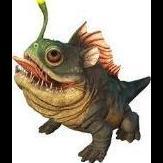
Wallog The Flying Frog ATV of The Center
ARKSmash posted a suggestion in Creature submission archive
Hi survivors today I present to you the Wallog (Rhacophorus Nigropalmatus) | The ATV Flying Frog of the Center References Frog Fun Facts | AMNH https://en.wikipedia.org/wiki/Wallace's_flying_frog Concept Explanation: I have played on the Center in creative mode, and know that for a long time Arkers have loved and still love this map, no matter how forgotten it was, and all of them were crushed when it was skipped in the votes, until now. I heard a certain “Arker” say that they wanted something similar to the Maewing. So something with a glide, and a jump, and good capability underwater. I didn’t just want to submit a sugar glider, or even a flying squirrel, I wanted something unique, that has all the capabilities that this “Arker” wanted. However this creature will differ from the Beelzebufo immensely in use, and hopefully it will become loved if it makes the submission. I know lots of people don’t use the Beelzebufo tons so I’m hoping the Wallog gives it more use in modern Ark. Since this frog is pretty tiny, I will be scaling it up so that it is big enough to be ridden. Ok let's begin. Behavior: The Wallog is going to be neutral, and when attacked will not deal significant amounts of damage. However, it does have a unique feature to befriend adolescent to adult frogs that will follow it. These frogs will affect taming and stats on the Wallog. More on the taming in that section. Utility: The Wallog is designed to be a fast way around the Center, on land using its powerful jump and glide (kinda like a Maewing), and in water using the same traits to zoom through the water. Its saddle will be unlocked at level 32 and can be crafted in your inventory. It will take no fall damage. Its glide will be a small bit slower than the Maewing, but the maneuverability will be a slight bit better, as well as the jump height. It will not be able to slide (hence the higher jump) on land or water, but will be able to still jump out of the water. It comes along with no oxygen stat, for maximum water travel potential.The Wallog will have a climbing ability (activated with RMB,) and will be able to cling to any surface after a jump. It will also have rider weaponry. Special Ability: If you tame a Wallog and you have up to 5 Beelzebufo following it, it will gain damage in percentage based on how many frogs are following it. The Wallog will gain 12% damage per frog, but it will not be 12% after the last 12% was counted, the 12% will always be added to the base damage that the Wallog was doing before the frogs followed it. However, this damage comes at the cost of losing your jump and glide. Don’t worry, all you have to do is make sure that the frogs stop following the tamed Wallog and you regain your jump and glide without having to cryo the frogs. Mate boost regardless of when it is placed in the equation results in the same number, so don’t worry about that. In order to make sure that these don’t become overpowered I’m going to make the cap of a tamed Wallog (tamed not imprinted) 300 damage. When you add that all up you get 638.4 which in damage numbers would be rounded down to 638. So in other words, if imprinted fully it can probably deal around 1000 damage a lick. LMB: A lick that deals around 100-300 damage depending on the level. AOE around 250o with 1 foundation reach. Every 5 licks, the Wallog will inflict a poison that slows by 25% and damages the victim for 10 seconds; the amount of damage dealt by the poison would be 2%. RMB: Activates Climbing Mode C Ability: When you hit C a crosshair will appear, and the Wallog will use its tongue as a grapple, the grapple controls would be the same as the normal grapple is, and you can deactivate the tongue by hitting C again. X Ability: Ability is based on what you feed it. Different X Abilities: Poison Attack, Night Vision/Vision Sharpener, and Camouflage. Poison Attack: Licks the target for no damage, but inflicts a 5 second 5% damage poison, this will stack with the basic LMB attack. Night Vision/Vision Sharpener: This can be activated no matter the time of day, but during the day instead of night vision, the Wallog enables its riders to see a clear white outline around each creature, similar to the tek helmet. At night it will be a night vision similar to the desmodus, except everything will be blue instead of red, and the frog won’t flash when night vision is enabled. Camouflage: Camouflage is going to be different for the Wallog than any other creature, when camouflage is enabled it will consume 5 stamina a second. But instead of going clear, the Wallog will actually change color when it moves to match the environment. Taming: To tame the Wallog you must kill all the Beelzebufo following it, since these are loyal followers to the Wallog you’re taming, the Wallog will also come and attack you. Then start knocking it out, once knocked out you must feed it one of the following things depending on how you want your Wallog to work with the taming food defining the X Ability. The Wallog will have a medium drain rate of torpor. Now depending on how many Beelzebufo you kill will give you a better roll for good stats, those stats being; melee, health, weight, and stamina, you will get 10% per frog to get this good roll. There will be one new item that will have to be added into the game, called the berry mixture made in the mortar and pestle. This will be a combination of amarberries, mejoberries, azulberries, and tintotberries, this will basically make taming the camouflage variant easier and can introduce a new thing for all herbivores. Taming Food: If you want to have any of these abilities you must feed the Wallog you are taming a certain food. Since one of these modes requires narcoberries, you will have to find a different way of keeping the Wallog knocked out like narcotics or even bio toxin, as long as it isn’t narcoberries. If you feed it narcoberries, you get the poison attack, this is the easiest of the modes to tame it, as when it eats the food, it will actually regain torpor. When feeding the Wallog chitin you will get the night vision/vision sharpener ability. When feeding the Wallog the berry mixture, you will get the camouflage. Dossier: A little note that I will be making dossier art for the Wallog Wild: The Rhacophorus Nigropalmatus seems to be the dominant frog species among the Beelzebufo, it seems that it has unique adaptation to help it survive in the murky swamp. An even bigger frog, who would’ve thought? When provoked the Rhacophorus unleashes its massive damage to protect its followers, if it has any. A Rhacophorus alone is extremely vulnerable to other creatures in the swamp. Domesticated: Strangely, based on what you feed the Rhacophorus changes its abilities. Adapted with a jump and even a glide, this will be a sure favorite for tribes who need to get around. It has a way with other frogs and can use them to increase its effectiveness in killing off unwanted creatures. No matter how slimy this creature is, there no debating that it has huge versatality. The End: Thank you for going through this whole submission, I’ll be happy to credit any ideas that are in the comments! Happy Arking Everybody! -ARKSmash -
From the album: Dossiers
Common Name: Argentavis Species: Argentavis atrocollum Time: Late Miocene Diet: Carrion-Feeder Temperament: Short-Tempered Wild: Lording over the skies across the island, Argentavis atrocollum has few aerial rivals. It is a small consolation for the island's other avian Creatures, then, that Argentavis seems to have little interest in anything alive. Although they are not interested in many animals, Argentavis will attack any human within sight making them an aerial threat to many humans with basic equipment. Quite apart from what I would have guessed, Argentavis does not have the stooped neck typical of modern buzzards and vultures. It is unknown if it adapted this stronger neck to deal with predators on the island, or if its lineage comes from before the stooped neck became common in carrion-eating birds. Domesticated: Argentavis is actually slower than the far more common Pteranodon, but it has significantly more Stamina, and can sustain flight for approximately three times as long. This makes them the best Creatures on the island for traveling or hauling cargo over long distances.-
- argentavis
- argent
- (and 8 more)
-
From the album: Dossiers
Common Name: Dimorphodon Species: Dimorphodon equesica Time: Early Jurassic Diet: Carnivore Temperament: Reactive Wild: Dimorphodon Equesica is another of the island's Jekyll-and-Hyde creatures. It is normally passive, sometimes even friendly. When provoked, it becomes very aggressive, even against larger creatures it has no business fighting... often to its own fatal end. Dimorphodon can make short work of smaller opponents, however, due to its large (but lightweight) skull and teeth. Barely a meter tall, Dimorphodon should be low on the food chain, but its incredible speed and surprisingly strong bite makes it fairly dangerous, especially en masse as they tend to attack in groups. A flock of angry or hungry Dimorphodon can take down prey several times their size, so survivors should take care not to hunt near where a flock is gathered. Domesticated: Dimorphodon is one of the creatures on the island that is easily domesticated for companionship. But its use in combat is also quite clear: it will hunt in large groups to seek out enemy dino riders directly, harassing them to no end—regardless of the might of the mount upon they may be astride!-
- dimorphodon
- dimo
- (and 8 more)
-
From the album: Dossiers
Common Name: Ichthyornis Species: Ichthyornis piscoquus Time: Late Cretaceous Diet: Piscivore Temperament: Skittish Wild: Among the most vocal creatures on the island, Ichthyornis Piscoquus is actually a relatively normal seagull. Living near the beaches, it primarily eats fish, and its distinctive cries can be heard echoing over literally every beach across the island. As you might expect from a seagull, Ichthyornis will flee at the slightest provocation. Ichthyornis is an excellent fish hunter, often catching and killing small-to-medium fish in one attack. Its primary method of predation is to dive into the top layers of water and impale or bite its prey. When looking for fish,Ichthyornis will often just fly in circles over the water and wait for its next opportunity to dine. Domesticated: Ichthyornis surprised me by being a very loyal and social creature, once tamed. It likes to ride on its owner's shoulder, and bring that person treats (in the form of fish, of course) which its beak-grip enhances with extra healing vitamins. The personality of Ichthyornis reminds me of a housecat hauling a dead lizard back to its family, except bringing extra-healthy fish instead.-
- ichthyornis
- bird
- (and 7 more)
-
From the album: Dossiers
Common Name: Bat Species: Onychonycteris specuncola Time: Eocene Diet: Omnivore Temperament: Aggressive Wild: Onychonycteris specuncola is one of the few omnivores I've seen on the island. They seem to live primarily off the mushrooms and moss within the caves, but they attack almost any non-insect on sight. They avoid Titanoboa whenever possible which leads me to believe the snake to be a natural predator of Onychonycteris. While flying in the dark caves would be difficult for any creature, Onychonycteris ability to use echolocation has allowed it to adapt perfectly. It can be found idly flying around the caves as often as it can be found hanging from bits of the cave ceilings. Domesticated: Not large enough to be used as mounts, and not strong enough to carry much, Onychonycteris still works well as a guard animal. Whether protecting a vacant home, or members of a tribe, their relatively vicious nature has its uses. -
From the album: Dossiers
Common Name: Quetzal Species: Quetzalcoatlus conchapicem Time: Late Cretaceous Period Diet: Carnivore Temperament: Skittish Wild: Quetzalcoatlus is one of the largest avians on the island. It shares a similar silhouette with the Pteranodon, and nests near the absolute highest peaks. Upon closer inspection, though, Quetzalcoatlus is an enormous creature of tremendous power. I find it strange that such a large, imposing beast would be so skittish. Unlike other creatures of its size, it is more likely to flee than fight. I suppose the decision to flee from any trouble keeps the species alive on an island with so many dangerous predators. But then how does it eat enough to sustain its massive size? Domesticated: Tamed Quetzalcoatlus have a very specific role on the island. Too slow to be an efficient local transport, and too weak to be an effective warbird, the tribes I have encountered tend to employ it as a mass carrier.Quetzalcoatlus is primarily used by these masters of the skies to safely carry vast quantities of supplies, creatures and human cargo from one base to another without tiring. -
From the album: Dossiers
Common Name: Pteranodon Species: Pteranodon wyvernus Time: Late Cretaceous Diet: Carnivore Temperament: Skittish Wild: Pteranodon wyvernus is a large pterosaur, capable of flying for incredibly long periods. While others I've seen on the island still call it a Pterodactyl, this is inaccurate. The Pteranodon seems to be one of the least aberrant Reptile on the island. Pteranodon wyvernus mostly feeds itself by eating the small fish around the island, but they can also be found scavenging any number of dead animals. Because of this they are one of the most common Creatures on the island. Domesticated: I don't know how they did it, but I once saw a trio of Pteranodons with riders on them. This must be the fastest way to get around the island, but it can't provide any measure of safety or secrecy.

